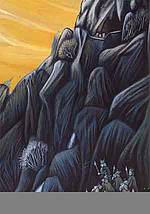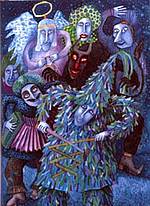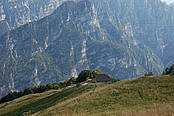The Pust (Carnival) of the Natisone Valleys
The Natisone Valleys lie in the eastern fringes of the Friuli-Venezia Giulia Region, where, in a centuries old tradition of the rural economy, the Pust (Carnival) marks the moment in the passage of the seasons when Winter turns to Spring. Even if they have different nuances, the forms of the expiatory and propitiary characters of this ancient ritual, closely linked to the area’s economy and culture, live on in the masked figures: le maschere belle e quelle brutte (the beautiful and ugly masks), il diavolo e l'angelo (the devil and the angel), and other traditional characters such as the pustici, the pustje, the minke, the blumarji...
These masked figures are the most characteristic features of the Natisone Valleys carnivals, and are made to unique and strictly defined designs, although similar examples may be found throughout the Alps. Pulfero is the home of the unique carnival of the blumarji di Montefosca, which is associated with a type of "initiation" rite. Other major carnivals include the Pustje of Mersino and Rodda, the Pustici of Matajur, the Carnival of Biacis, the Carnival of Stregna, the Pustje and the Minke of Masarolis and other "contemporary" masked figures such as those of Clodig.
Stories of Krivapetes
The story I am about to tell began many years ago, and concerns a mysterious and intriguing figure whose name still resonates with me: Krivapeta. It has the sound of branches broken by a woodland animal walking through the undergrowth. If I had been content merely to listen to this creaky sound, as so many are in the silence of the woods, the story could finish here, but...I made up my mind to discover more about it, and curiosity drew me to the Valleys where I might learn more of the oral tradition, that river of life that runs abundantly through the Valleys, and what it had to say about the Krivapetes. I tramped the Valleys in all seasons of the year – these Valleys that are beautiful no matter what the season – stopping people I met along the way, and, with some embarrassment, asking each one: "Who are the Krivapetes, where do they live, and what are they like?"
In reply they told me many stories and legends. I will tell you one, or possibly two. One foggy day I returned to Raune to speak to Peter about the Krivapetes. Pointing at something that was clear to him, but still obscure to me, he told this tale:
"Once, long ago, a Krivapeta lived near the spring where there is still a small cave. She was married, and had a beautiful little girl. One day her husband called her Krivapeta, and she was so offended that she went off to live alone in the cave, returning each evening to comb her daughter’s hair. She used to be seen cutting the grass; now it is completely abandoned, but once there was a meadow there. She was a woman of average appearance, neither ugly nor beautiful, with feet that were back to front. She was no harm to anyone. Everyone said she was mad when they saw her gathering the grain before it was ripe, but a hailstorm came and destroyed everyone’s grain but hers. She knew."
I had read this story about the hailstones in numerous books, but when I heard it from Peter it sounded true.
I remembered a story I had heard from Stefano, in Cernizza, who said that you should listen to the old people of a place, because they live closer to the truth.
Stefano has the story-teller’s art, and knows so much, of Krivapetes, spirits, and the mysterious deeds and enchanted places of the Valleys, and if he ever forgets anything, he can always find some relation to remind him. One story leads to another, as his memories return. One day we went to see his aunt at Blasin, where, according to tradition, the first Krivapetes were born, with their heels back to front. We sat around the table unaware of the time passing, exchanging stories and sipping the nocino walnut liqueur, until the aunt decided the time was right to tell her tales.
This is one of them.
"Once, many years ago, the people of the Valleys knew very little. In the Summer, when the villagers of Sorzento were going to collect water from the Tarnje stream, they saw some Krivapetes washing their feet in the distance. Everyone knew that they understood things that no-one else knew about, and the men would often call out to them from afar in the hope that they would reveal some of their secrets. But they never did."One day a man, seeing a Krivapeta sleeping under a chestnut tree, tied her with a rope and took her back to his village, where everyone came and asked her questions. 'I will teach you everything if you set me free', she said. The villagers agreed, and so the Krivapeta began teaching them to make butter, cook gubana, make slippers, weave baskets and sharpen their knives. When she had finished, she said to villagers 'Now that I have taught you all I know, you must set me free'. Once free, she ran off towards the mountain and shouted: 'I have taught you everything, except how to make sugar'."
I returned home with the sun setting behind the green valley slopes. Why are the Valleys so special? I believe there is something sacred about them, permeating everything, as in the Garden of Eden that man once possessed and then lost. Here he can rediscover it. Their legends convey secrets, preserved in the mother tongue that grew from the earth, the wind, the flowing streams and the rustle of the woods. A mysterious language that hides and reveals an intriguing and resonant name: Krivapeta.
For a long time I wondered why the Krivapetes teach almost, but not quite, everything. The answer came from Ada, of Sorzento:
"You know, there are secrets that can’t be revealed".
Aldina De Stefano
Aldina De Stefano
Degree Thesis: Le krivapete delle Valli tra storia e leggenda (The Krivapetes of the Valleys in History and Legend)
University of Urbino
Academic Year 1998-99
The thesis was presented by the Mountain Community of the Natisone Valleys in partnership
with the Municipal Library of San Pietro al Natisone on 17 February 2000.
A copy is deposited at the Mountain Community of the Natisone Valleys
 |
The Legend of Queen Vida
The Cave of San Giovanni of Antro
Once upon a time Queen Vida lived with her servants in Biacis castle. Everyone loved her and worked for her to repay her generosity and kindness of heart.
One day word reached her that Attila was approaching the Valleys of Natisone with his army of mounted soldiers in iron armours, armed with axes and swords. Everyone was afraid that they would sack the villages, burn the homes and kill the villagers. So Queen Vida called all the people of the Valleys to the castle, and gave these orders:"My people, Attila and the Huns are coming. Round up your animals; gather grain, supplies, clothing and everything you can manage. We must escape as soon as we can to the Cave of San Giovanni of Antro. We must set off within the hour."
After one hour, the people had assembled in front of the castle. After the Queen had checked that everyone was present and had brought along everything they needed, she set off with her servants and all the men, women and children. The men led the animals and carried scythes, food, and sacks of grain, while the women carried the infants and the older children each carried a bundle of pots, pans and blankets.
They arrived at the Antro’s Cave. One by one they climbed up the rocks towards it, pulling up the animals and anything else they had brought along. Inside there was a stream providing water, a mortar to grind the grain and make flour, an oven to bake bread, shelter for the animals, beds of straw and everything needed for a long stay in the cave.
And so it was that Attila and his Huns arrived in the Natisone valley, only to find deserted villages, abandoned houses and empty stables. Attila turned to his soldiers and shouted: "They must have hidden themselves. Find them without delay. If you can’t tell me where they are in one hour’s time, the worse for you!" The soldiers searched everywhere, but found nothing. One, however, noticed a movement near Antro’s cave and realised that the people had hidden there. Attila ordered his soldiers to climb up, seize the refugees and bring them down. When the soldiers reached the rocks they began to climb, but were forced to retreat because the villagers were throwing stones down at them. Attila then ordered them: "Stop. We shall wait here until they run out of food and are forced to surrender!" Months passed, and the Huns continued to wait beneath the rocks. Meanwhile the villagers in the cave had begun to exhaust their supplies. Even though the Queen had ordered that only a little bread should be baked each day, finally only one sack of grain remained.
She then gathered the people all around and said: "We cannot last much longer with one sack of grain. Let’s use it to fool the Huns". Next day Queen Vida, from high on the rock, emptied the sack of grain before the eyes of the Huns, shouting: "Count the grains! We have a sack for every grain!" Seeing this, Attila summoned his soldiers and said: "If they can afford to throw away their grain, they must be well supplied. Perhaps they leave the cave at the rear to find new supplies. We’ll go further down the valley to look for better places".
As Attila and the Huns were riding off to Cividale and the Friulian Plain, Vida ordered the villagers to return home. And so the people of the Valleys of Natisone continued to live in peace, and to respect and love the Queen whose wisdom had saved them.
Text and illustrations from Sonce sieje published by Lipa 1998








